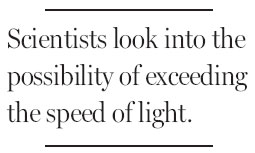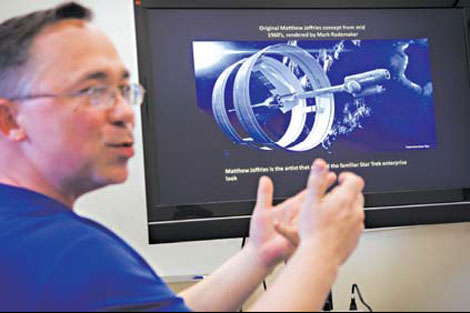Pulling warp drive nearer plausibility
Updated: 2013-09-01 08:11
By Danny Hakim(The New York Times)
|
|||||||
|
Harold G. White, a NASA physicist, has redesigned a theoretical warp-traveling spacecraft. Michael Stravato for The New York Times |
HOUSTON - At the Johnson Space Center's 1960s-era campus here, Harold G. White and other NASA engineers have been redesigning an assortment of instruments - a laser, a camera, small mirrors - with the goal of using them to warp the trajectory of a photon, changing the distance it travels in a certain area.
Working in a specially built vibration-free lab, the team is trying to determine whether faster-than-light travel might be possible. Warp drive. Like on "Star Trek."
"Space has been expanding since the Big Bang 13.7 billion years ago," said Dr. White, 43, a physicist and advanced propulsion engineer who runs the research project. "And we know that when you look at some of the cosmology models, there were early periods of the universe where there was explosive inflation, where two points" would have receded "away from each other at very rapid speeds."
"Nature can do it," he said. "So the question is, can we do it?"
Einstein postulated that, as Dr. White put it, "thou shalt not exceed the speed of light," essentially setting a galactic speed limit. But in 1994, a Mexican physicist, Miguel Alcubierre, theorized that faster-than-light speeds were possible in a way that did not contradict Einstein.
Dr. Alcubierre's theory involved harnessing the expansion and contraction of space. Under his hypothesis, a ship still could not exceed light speed in a local region of space. But a theoretical propulsion system he sketched out manipulated space-time by generating a "warp bubble" that would expand space on one side of a spacecraft and contract it on another.
"In this way, the spaceship will be pushed away from the Earth and pulled towards a distant star by space-time itself," he wrote.
But Dr. Alcubierre's paper was purely theoretical, and suggested insurmountable hurdles. Among other things, it depended on large amounts of a little understood or observed type of "exotic matter" that violates typical physical laws.

Dr. White believes that advances he and others have made render warp speed less implausible. Among other things, he has redesigned the theoretical warp-traveling spacecraft - and in particular a ring around it that is key to its propulsion system - in a way that he believes will greatly reduce the energy requirements.
He is quick to offer up caveats, saying his research is just trying to prove that a microscopic warp bubble can be detected in a lab. "We're not bolting this to a spacecraft," he said.
Theoretically, a warp drive could cut the travel time between stars from tens of thousands of years to weeks.
"My personal opinion is that the idea is crazy for now," said Edwin F. Taylor, a former editor of The American Journal of Physics and senior research scientist at Massachusetts Institute of Technology. "Check with me in a hundred years."
But Richard Obousy, a physicist who is president of Icarus Interstellar, a nonprofit group composed of volunteers collaborating on starship design, said "it is not airy-fairy, pie in the sky."
"We tend to overestimate what we can do on short time scales, but I think we massively underestimate what we can do on longer time scales," he said of the work of Dr. White, who is a friend and Icarus collaborator.
Neil deGrasse Tyson, an astrophysicist at the American Museum of Natural History, said some leap beyond our current technology would be needed to make interstellar travel feasible.
"Routine travel among the stars is impossible without new discoveries regarding the fabric of space and time, or capability to manipulate it for our needs," he said, adding, "By my read, the idea of a functioning warp drive remains far-fetched, but the real take-away is that people are thinking about it - reminding us all that the urge to explore continues to run deep in our species."
The New York Times
(China Daily 09/01/2013 page11)
